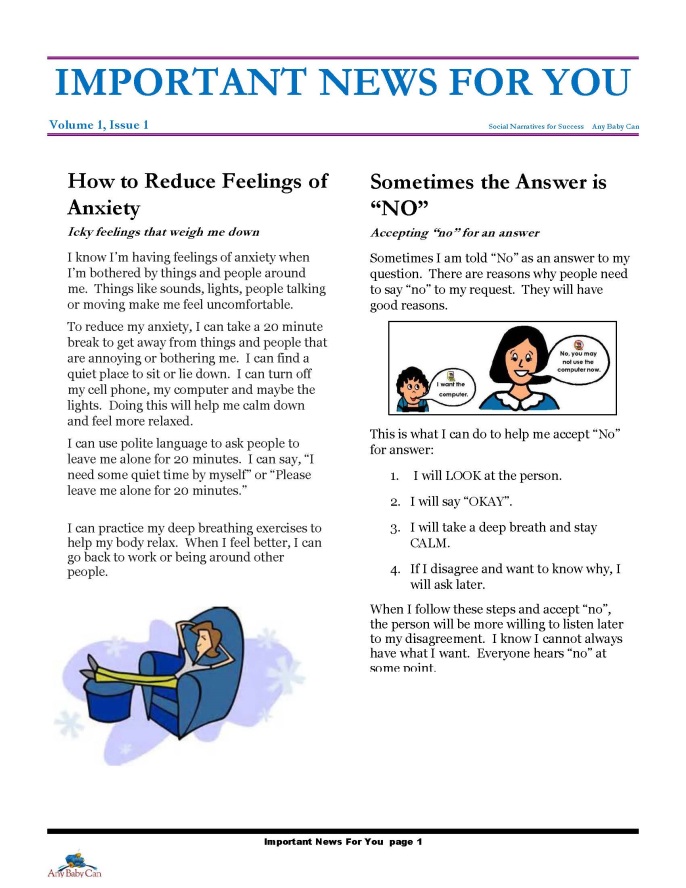Many school students carrying the diagnosis of Asperger’s Syndrome exhibit challenges in the area of social interactions and social skills. These social difficulties are worrisome for parents and family members who look for supports to address these challenges. Struggles in the school setting often center on their child’s inability to “fit in” with other students or an inability to grasp social expectations from their teachers and peers. Additionally, their child’s feelings of high anxiety and stress can make the learning environment challenging for them and the people around.
Over time, I’ve listened to concerns from parents and teachers regarding a student’s lack of understanding when it comes to social situations in the classroom environment. This often leads to isolation and the need for behavior support.
There is information in the literature that suggests both adult and peer mediated techniques to teach and build social skills in children with autism.
Strategies that are directed by an adult include reinforcement of shaped social skills. This is a technique where the child is reinforced when they demonstrate closer and closer approximations of a desired behavior. Peer mediated strategies incorporate the use of proximity, prompts with reinforcement, and teaching peer initiation. The literature also supports using social scripts to capitalize on visual learning methods (Krantz and McClannahan 1993).
In my experience, I’ve observed how visual supports can be very beneficial in producing non-transient messages for the student to follow and use during social situations. When paired with direct instruction using ABA techniques like shaping and reinforcement, social skills training can be accomplished.
When you set out to develop visual supports, first perform an internet search to get some ideas.
Visuals to build social skills can be used proactively to teach desired responses and as visual reminders during the day. No special software or extensive training is required to develop and implement these types of supports. Customizing to meet the specific situation and need of the individual is easy to do and important. Generalization and increased independence across settings is the ultimate goal.
One strategy that has been found to be very useful for individuals with Asperger’s is social narratives such as
- Social Scripts,
- Social StoriesTM (Gray, 2000)
- and Power Cards (Gagnon, 2001).
These types of supports provide written and pictorial instruction on specific social situations. There are minimal guidelines to follow when developing these supports for the best results. I have found that even spur of the moment handwritten messages about a situation are helpful as well.
When I’m asked to support a middle or high school student, I look for age appropriate ways to share information and teach these students about specific social expectations. One fun and inviting visual support format I have found is to use a newsletter template to share the information.
The example depicts a couple of social narratives for a particular student. One narrative is on how to reduce anxiety and the other is on how to accept “no” for an answer. As I work with a student, I continue to add additional social narratives by adding new issues to the newsletter. Doing this keeps the newsletter relevant and current to the specific needs of the student.
Ask the student for their input when creating social narratives!
It’s also a good idea to request input from the individual student on types of narratives and potential pictures that might be good to illustrate the social skill. Involving the student in customizing the newsletter generates “buy in” on their part. I also like to organize the newsletters in a notebook binder for easy access for review at the start of the school day or before known stressful situations come up.
In summary, when confronted with challenges related to a child’s social skills, try developing visual supports. These supports can help increase the individual’s ability to perform the skill and understand why it’s important. Consult with classroom teachers who might share their skills in developing visual supports. Asking for their expertise not only helps address underdeveloped social skills for the student, but also supports a team effort to provide successful educational programming.
by Tisha Gonzalez/Bee Social Network
Gagnon, E. (2001). The Power Card Strategy: Using Special Interests to Motivate Children and Youth with Asperger Syndrome. Shawnee Mission, KS: Autism Asperger Publishing Company.
Gray, C.A. (2000). The New Social Story Book™. Arlington, TX: Future Horizons.
Krantz, P. J., & McClannahan, L. E. (1993). Teaching children with autism to initiate to peers: Effects of a script-fading procedure. Journal of Applied Behavior Analysis, 26, 121-132.
Gabriela Lemos was born in Porto Alegre, Brasil, and was raised in San Antonio, Texas. She is currently a student at UTSA, graduating in December 2014 with a Bachelor degree in English. Brie states that she loves language and words, and the way in which people communicate with each other. She has always been interested and attracted to the autism community. “I find those on the spectrum to be incredible in so many ways, and I believe we can all learn from each other in our different strengths and weaknesses. I would love to use my talents to aid those who are not as strong in areas which I have confidence, and in turn receive an infinite amount of lessons and aid from those who I work with. Everything you send out, comes back to you, and I plan to practice sending out love and compassion every day”. We feel so fortunate to offer Brie’s talent of writing as well as her passion for autism awareness every week through our Aspergers101 Weekly.




I would love more examples of the newsletters! I can see how that would be helpful!